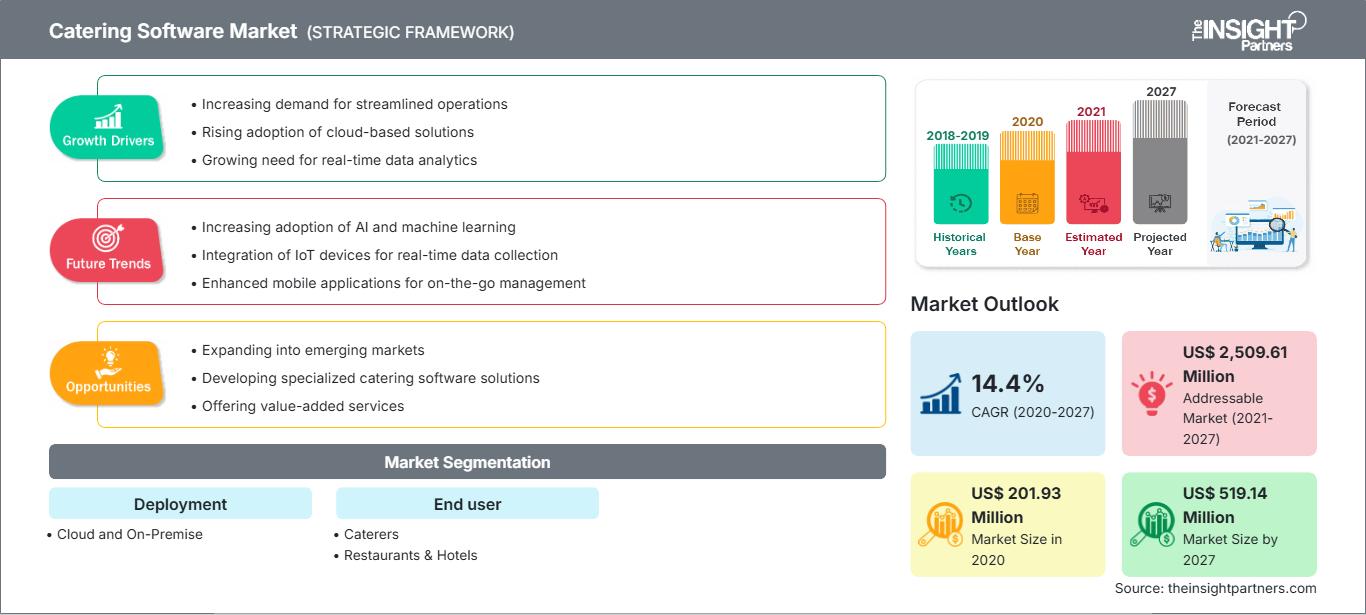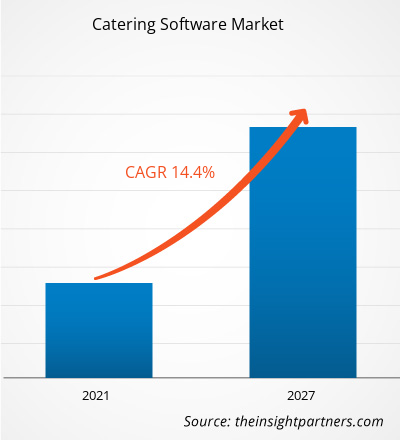Der Markt für Catering-Software soll von 201,93 Millionen US-Dollar im Jahr 2020 auf 519,14 Millionen US-Dollar im Jahr 2027 wachsen; von 2020 bis 2027 wird ein CAGR von 14,4 % erwartet.
Big-Data-Analysetechnologie zur Verbesserung der Catering-Abläufe trägt zum Marktwachstum bei. Die Big-Data-Analysetechnologie hat ein enormes Potenzial, das Catering-Geschäft vollständig zu verändern. Die Einführung von Big-Data-Lösungen trägt dazu bei, die Effizienz von Vertriebs- und Produktionsnetzwerken in der gesamten Catering-Branche zu verbessern. Die Technologie ermöglicht die Verfolgung des gesamten Transportprozesses von Lieferungen. Dank Echtzeit-Einblicken können Kunden ihre Bestellungen auf ihren Geräten verfolgen und den Catering-Status überprüfen. Die Integration eines Analyse-Dashboards in die Catering-Software hilft dabei, die Leistung von Catering-Agenten zu verfolgen und zu bewerten. Darüber hinaus muss jeder Beteiligte im Catering-Geschäft über relevante Daten zu seinen Produkten verfügen, einschließlich Daten zu Landwirten, Spediteuren und Einzelhändlern bis hin zu Restaurants und Geschäften. Beispielsweise nutzt das KFC-Restaurant Big Data-Tools, um Kundenfeedback und Essensvorlieben zu analysieren und so das Kundenerlebnis, den Umsatz und den Gewinn zu verbessern.
Die E-Commerce-Branche hat in den letzten Jahren in allen Regionen zahlreiche Transformationen erlebt. Das Wachstum der Branche hat die Akteure im Catering-Softwaremarkt dazu veranlasst, Big Data-Analysen zu nutzen, um intelligentere Geschäftsentscheidungen zu treffen. Die Technologie ermöglicht es Online-Händlern, Kundeninteraktionen über verschiedene Kanäle wie Mobilgeräte, soziale Medien und Websites auszuwerten.
Passen Sie diesen Bericht Ihren Anforderungen an
Sie erhalten kostenlos Anpassungen an jedem Bericht, einschließlich Teilen dieses Berichts oder einer Analyse auf Länderebene, eines Excel-Datenpakets sowie tolle Angebote und Rabatte für Start-ups und Universitäten.
Markt für Catering-Software: Strategische Einblicke

- Holen Sie sich die wichtigsten Markttrends aus diesem Bericht.Dieses KOSTENLOSE Beispiel umfasst Datenanalysen, die von Markttrends bis hin zu Schätzungen und Prognosen reichen.
Auswirkungen der COVID-19-Pandemie auf den Markt für Catering-Software
Sie erhalten kostenlos Anpassungen an jedem Bericht, einschließlich Teilen dieses Berichts oder einer Analyse auf Länderebene, eines Excel-Datenpakets sowie tolle Angebote und Rabatte für Start-ups und Universitäten.
Markt für Catering-Software: Strategische Einblicke

- Holen Sie sich die wichtigsten Markttrends aus diesem Bericht.Dieses KOSTENLOSE Beispiel umfasst Datenanalysen, die von Markttrends bis hin zu Schätzungen und Prognosen reichen.
Nach dem weltweiten Ausbruch der COVID-19-Pandemie waren einige Unternehmen aufgrund verschiedener Eindämmungsmaßnahmen von Regierungen weltweit gezwungen, ihre Geschäftstätigkeit einzuschränken. Die schnelle Ausbreitung des Virus veranlasste Regierungen weltweit, strenge Beschränkungen für die Bewegung von Personen und Fahrzeugen zu erlassen. Unternehmen, deren Umsatz auf physische Interaktion angewiesen ist, wurden durch die Lockdowns schwer geschädigt. Daher konzentrieren sich einige Unternehmen darauf, Konversionen, Interaktionen und Umsätze über digitale Medien zu steigern.
Markteinblicke – Markt für Catering-Software: Maschinelles Lernen revolutioniert das Catering-Geschäft
In der Gastronomie führen die unzureichende Flächenkartierung und das Ungleichgewicht zwischen Nachfrage und Ressourcenverfügbarkeit zu zahlreichen Herausforderungen. Maschinelles Lernen und künstliche Intelligenz (KI) bilden die Grundlage der Catering-Technologien der nächsten Generation. Diese Technologien ermöglichen es Systemen, aus aufgezeichneten Daten zu lernen, die Algorithmen, Muster und prädiktive Erkenntnisse umfassen. Mehrere Online-Essenslieferanten setzen auf Machine-Learning-Technologie, um ihr Catering-Geschäft zu verbessern und die Effizienz zu steigern. Beispielsweise investiert Deliveroo, ein britischer Essenslieferant, in fortschrittliche Technologien wie Machine Learning, um durch einen effektiveren Essenslieferservice wettbewerbsfähig zu bleiben. Glovo, ein spanischer Essenslieferant, nutzt ebenfalls Machine Learning, um die Wahrscheinlichkeit zu prognostizieren, mit der Nutzer die App weiterhin nutzen. Daher wird erwartet, dass die Integration von Machine Learning in Catering-Unternehmen die Nachfrage nach Catering-Software im Prognosezeitraum steigern wird.
Bereitstellungsbasierte Erkenntnisse
Basierend auf der Art der Bereitstellung ist der Markt für Catering-Software in Cloud und On-Premises segmentiert. Das Cloud-Segment hatte 2019 den größten Marktanteil.
Markt für Catering-Software
Die Analysten von The Insight Partners haben die regionalen Trends und Faktoren, die den Markt für Catering-Software im Prognosezeitraum beeinflussen, ausführlich erläutert. In diesem Abschnitt werden auch die Marktsegmente und die geografische Lage in Nordamerika, Europa, dem asiatisch-pazifischen Raum, dem Nahen Osten und Afrika sowie Süd- und Mittelamerika erörtert.Umfang des Marktberichts zur Catering-Software
| Berichtsattribut | Einzelheiten |
|---|---|
| Marktgröße in 2020 | US$ 201.93 Million |
| Marktgröße nach 2027 | US$ 519.14 Million |
| Globale CAGR (2020 - 2027) | 14.4% |
| Historische Daten | 2018-2019 |
| Prognosezeitraum | 2021-2027 |
| Abgedeckte Segmente |
By Bereitstellung
|
| Abgedeckte Regionen und Länder | Nordamerika
|
| Marktführer und wichtige Unternehmensprofile |
|
Dichte der Marktteilnehmer für Catering-Software: Verständnis ihrer Auswirkungen auf die Geschäftsdynamik
Der Markt für Catering-Software wächst rasant. Dies wird durch die steigende Nachfrage der Endnutzer aufgrund veränderter Verbraucherpräferenzen, technologischer Fortschritte und eines stärkeren Bewusstseins für die Produktvorteile vorangetrieben. Mit der steigenden Nachfrage erweitern Unternehmen ihr Angebot, entwickeln Innovationen, um den Bedürfnissen der Verbraucher gerecht zu werden, und nutzen neue Trends, was das Marktwachstum weiter ankurbelt.

- Holen Sie sich die Markt für Catering-Software Übersicht der wichtigsten Akteure
Akteure auf dem Markt für Catering-Software konzentrieren sich hauptsächlich auf die Entwicklung fortschrittlicher und effizienter Produkte.
- Im Jahr 2020 investierte CaterZen seit Anfang März Programmierstunden, um sicherzustellen, dass Restaurants und Caterer ihren Betrieb durch eine starke Konzentration auf Online-Bestellungen und Essenslieferung aufrechterhalten können.
- Im Jahr 2020 führte Flex Catering das Catering-KDS (Kitchen Display System) ein, eine Art digitaler Bildschirm, der gedruckte oder handschriftliche Bestellscheine in Restaurants und Lebensmittelunternehmen ersetzt.
Der Markt für Catering-Software wurde wie folgt segmentiert: Globale Catering-Software – nach Bereitstellung
- Cloud
- Vor Ort
Globale Catering-Software – nach Endbenutzer
- Caterer
- Restaurants und Hotels
- Sonstige
Globaler Markt für Catering-Software – nach Geografie
Nordamerika
- USA Pazifik (APAC)
- Japan
- China
- Australien
- Indien
- Südkorea
- Rest von APAC
Naher Osten und Afrika (MEA)
- Saudi-Arabien
- VAE
- Südafrika
- Rest von MEA
Südamerika (SAM)
- Brasilien
- Argentinien
- Rest von SAM
Markt für Catering-Software – Firmenprofile
- Aptus Systems Ltd.
- Better Cater, Inc
- Caterease Software
- CaterTrax, Inc.
- CaterZen von Restaurant & Catering Systems
- Flex Catering
- FoodStorm Catering Software (CaterXpress)
- Planning Pod (My Wedding Workbook, LLC)
- Profit Systems Inc.
- Pxier
- Historische Analyse (2 Jahre), Basisjahr, Prognose (7 Jahre) mit CAGR
- PEST- und SWOT-Analyse
- Marktgröße Wert/Volumen – Global, Regional, Land
- Branchen- und Wettbewerbslandschaft
- Excel-Datensatz
Aktuelle Berichte
Verwandte Berichte
Erfahrungsberichte
Grund zum Kauf
- Fundierte Entscheidungsfindung
- Marktdynamik verstehen
- Wettbewerbsanalyse
- Kundeneinblicke
- Marktprognosen
- Risikominimierung
- Strategische Planung
- Investitionsbegründung
- Identifizierung neuer Märkte
- Verbesserung von Marketingstrategien
- Steigerung der Betriebseffizienz
- Anpassung an regulatorische Trends




















 Kostenlose Probe anfordern für - Markt für Catering-Software
Kostenlose Probe anfordern für - Markt für Catering-Software